Trends in Interactive Toys to Stimulate Pets’ Minds

The Growing Popularity of Interactive Pet Toys
The world of pet ownership is evolving, and pet owners are becoming increasingly aware of the importance of mental stimulation for their pets. Today’s interactive toys are not just simple playthings; they serve a profound purpose in enhancing the lives of cats and dogs alike. Designed to engage and challenge a pet’s intellect, these toys fulfill their natural instincts to explore and solve problems.
A wealth of research backs the notion that mental stimulation can significantly improve a pet’s quality of life. Here’s a closer look at some notable benefits associated with interactive toys:
- Enhanced Problem-Solving Skills: Toys that require dogs and cats to manipulate objects to retrieve treats can sharpen their cognitive abilities. For example, puzzle feeders that dispense food only after the pet successfully navigates a series of challenges promote critical thinking and strategic planning.
- Reduced Anxiety: Many pets experience anxiety from boredom, which can lead to destructive behaviors. Interactive toys, such as those that mimic prey movement or provide engaging sounds, can help alleviate stress. A study published in the Journal of Veterinary Behavior found that providing enrichment activities significantly decreased signs of stress in sheltered dogs.
- Physical Exercise: In addition to mental engagement, many interactive toys promote physical activity. Toys that encourage fetch and chase not only keep your pet active but also strengthen the bond between owner and pet during playtime, encouraging a routine that benefits both parties.
With the notable benefits prompting pet owners to rethink their purchases, the market is witnessing a surge in innovative designs that cater to these needs. From sophisticated electronic games that challenge a pet’s agility to simple yet effective treat-dispensing toys, the selection is continually expanding. Brands like Outward Hound and PetSafe offer a variety of interactive toys that enthusiasts have praised for their effectiveness and durability.
Pet owners are now more than ever shopping with intention, seeking toys that double as tools for mental enrichment and engagement. The latest trends showcase technological advancements, such as smart toys that connect to mobile apps, enabling owners to monitor their pets’ playtime and activity levels directly. These innovations pave the way for future developments in pet care, ensuring that playtime becomes a valuable learning experience.
In conclusion, the rise of interactive toys presents a revolutionary shift in how we approach pet care. These products not only provide entertainment but also serve critical functions in enhancing our pets’ emotional and mental well-being. As awareness spreads, the demand for such toys will likely continue to grow, ushering in a new era of pet companionship that’s both entertaining and enriching.

LEARN MORE: Click here to discover how early socialization can make a difference
Innovative Designs Shaping the Interactive Toy Market
The landscape of interactive pet toys is rapidly evolving, driven by innovative designs that prioritize mental stimulation and engagement. As pet owners continue to strive for a deeper connection with their furry companions, these toys have adapted to meet their needs. Among the leading trends, we find toys that leverage technology, sustainability, and versatility. Each trend not only enhances the play experience but also caters to the modern pet owner’s desire for high-quality, interactive options.
High-Tech Toys That Engage
One of the most exciting trends in the interactive toy market is the introduction of smart technologies. Toys equipped with sensors and connectivity features allow pet owners to monitor their pets’ activities through mobile applications, bridging the gap between technology and play. For instance, smart laser pointers and automatic ball launchers can engage pets in self-directed play while providing owners with insight into their pets’ movement patterns and playtime habits. This data-rich approach not only allows owners to track their pet’s exercise but also ensures that their pets stay engaged, thereby reducing boredom and related behaviors, such as chewing or scratching.
Sustainability in Mind
As environmental awareness grows, many companies are pivoting towards creating eco-friendly interactive toys. Brands are exploring materials that reduce plastic waste, such as recycled fibers and biodegradable substances. These toys not only serve their purpose of stimulating pets’ minds but also resonate with owners who want to make environmentally conscious choices. For example, biodegradable puzzle toys made from natural rubber can provide both mental and physical activities while minimizing environmental impact.
Customizable Experiences
Another notable trend encompasses the rise of customizable interactive toys that cater specifically to an individual pet’s preferences and skill levels. Toys that allow pet owners to adjust difficulty settings or add varying treat sizes enable a more personalized experience, keeping pets consistently challenged and entertained. Some multi-functional toys come with replaceable parts, which means they can be adapted as pets grow or as their interests change. This adaptability is crucial for long-term engagement and prevents the common pitfall of toy fatigue.
Benefits Beyond Play
The emergence of interactive toys that stimulate pets’ minds serves to enhance not just playtime, but also emotional well-being. Owners increasingly recognize the significance of investing in their pets’ cognitive development, as optimal mental stimulation can lead to improved behavior and a stronger bond between pets and their owners. As interactive toys become more intricate and engaging, pet parents are witnessing a shift in their pets’ behavior, including increased happiness and reduced anxiety levels.
With the myriad of choices now available, pet owners are embracing the responsibility of choosing toys that will enrich their pets’ lives. The rapidly growing market reflects a shared understanding that mental stimulation is not just an option; it’s a vital component of a pet’s overall wellness. As innovative designs continue to emerge, the future holds even greater potential for enhancing playtime through creative and enriching experiences.
| Category | Insights |
|---|---|
| Engagement Technology | Interactive toys using AI and app connectivity foster mental stimulation and keep pets engaged. |
| Cognitive Development | These toys enhance problem-solving skills, teaching pets to think critically while also promoting bonding during playtime. |
| Behavioral Benefits | Interactive toys address issues like boredom and destructive behavior by channeling energy into productive play. |
| Variety of Options | From puzzle feeders to automated fetch toys, the diversity of options caters to different pets’ preferences and needs. |
The rise of interactive toys provides pet owners an opportunity to not only keep their furry companions entertained but also engage their minds, paving the way for greater happiness and health. As animals thrive in environments that stimulate their curiosity, the effectiveness of these toys cannot be overstated. Investigating further into these innovations allows consumers to make informed decisions and find the perfect match for their beloved pets.
DISCOVER MORE: Click here to learn how to help your cat
The Role of Interactive Toys in Training and Behavior Modification
Beyond simple entertainment, interactive toys are also proving to be invaluable tools in training and behavior modification for pets. As behavioral issues among pets become increasingly prevalent, the pet industry is responding with toys specifically designed to aid in managing and correcting these behaviors. There are notable trends emerging in this arena, especially focusing on positive reinforcement, skill development, and interactive learning.
Positive Reinforcement Tools
Positive reinforcement is a cornerstone of effective pet training. Interactive toys that dispense treats as rewards for solving puzzles or completing tasks are a prime example. Such toys encourage pets to think critically and engage in problem-solving while providing immediate gratification for successful actions. Brands like Petcube have pioneered interactive cameras with built-in treat dispensers, allowing owners to reward their pets even when they are away from home. These features not only create bonding opportunities but also help in reinforcing desired behaviors, such as following commands or completing tasks successfully.
Enhanced Learning Experiences
Today’s interactive pet toys also focus on developing a pet’s skills through play. Toys featuring various textures, sounds, and puzzles can stimulate different senses, promoting cognitive development. For example, activity mats designed with various challenges can encourage dogs and cats to use their reasoning to uncover hidden treats. These learning experiences can be particularly beneficial during a pet’s formative years, as they lay the groundwork for appropriate behaviors and coping skills.
Emotionally Intelligent Play
The emotional intelligence of pets is another focus for interactive toy designers. Many new toys are engineered to recognize a pet’s mood and adjust their interactions accordingly. These advances range from simple plush companions that respond with sound or movement when a pet exhibits excitement, to more complex interactive toys that can sense when a pet is feeling anxious or lonely and provide comfort through soothing sounds or gentle movements. This emotional engagement not only entertains pets but also helps to alleviate anxiety and other behavioral issues, further integrating the concept of mental wellness into playtime.
Social Interaction and Group Play
Interactive toys are not limited to individual play; they are increasingly designed to facilitate social interaction among pets. Toys that can connect multiple units for group play encourage socialization and engagement between multiple pets. For instance, remote-controlled toys that move around and interact with other pets in the household can foster a sense of cooperation and competition, essential for developing social skills. These group-focused toys can be particularly beneficial in multi-pet households, providing opportunities for bonding and exercise.
Moreover, engaging play sessions that involve multiple pets often lead to a decrease in negative behaviors stemming from boredom, such as barking, digging, or destructive chewing. Pet owners are turning toward these interactive solutions as a means to create a more balanced environment at home.
As this trend continues to evolve, the pet industry is recognizing the need for toys that not only stimulate the mind but also address behavioral issues and promote training. By leveraging innovative designs, smart technologies, and emotional intelligence, the interactive toy market is reshaping our approach to nurturing our pets’ mental and emotional well-being.
DIVE DEEPER: Click here to learn more
Conclusion: Embracing the Future of Pet Play
The landscape of interactive toys for pets is thriving, driven by a profound understanding of our furry companions’ mental and emotional needs. As we delve into the realm of pet care, it becomes increasingly clear that these toys transcend mere amusement; they lay the foundation for effective training, behavioral improvements, and emotional well-being. From customizable tools that reward positive behavior to sophisticated designs that adapt to a pet’s mood, the innovation in this sector is remarkable.
The emergence of emotionally intelligent toys reflects a broader shift towards fostering a holistic approach to pet ownership. As pet owners in the United States seek not only entertainment but meaningful engagement, the demand for toys that combine cognitive stimulation with emotional connection will undoubtedly continue to grow. In multi-pet households, group play options enhance social skills and mitigate behavioral issues, addressing a common challenge faced by pet owners.
As the industry continues to innovate, exploring advancements in technology, quality of interaction, and behavioral enhancements, owners are presented with a diverse array of options to enrich their pets’ lives. The future of pet toys appears bright, promising intriguing possibilities that invite us to rethink how we engage with our pets. Investing in these tools not only entertains our pets but also builds stronger connections, fostering a well-rounded, mentally stimulated, and emotionally secure environment.
In embracing these trends, pet owners are not just improving playtime; they are paving the way for a more fulfilling life for their beloved companions.


